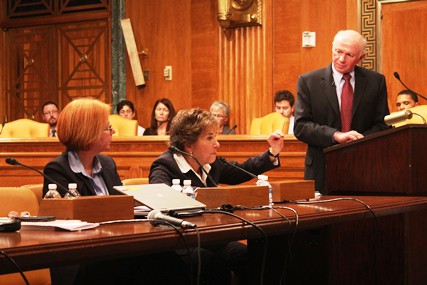This week America’s wealthiest will make their last contribution to the Social Security system for 2015. The rest of us…middle class and the working poor…will continue to pay 6.2% of every dollar we earn to keep Social Security strong. How can this be?
So, the payroll tax cap means the wealthy will never have to contribute on all of their income, just the first $118,500 (in 2015). Because most Americans never earn that much in a year, many don’t even realize this unfair tax cap exists or the devastating effect it’s having on Social Security’s long-term fiscal outlook:
“… the Social Security trust fund, which currently holds $2.8 trillion, is projected to be drawn down by about 2033 (according to the Social Security trustees). After that point, if no changes are made to the program, retirees will receive only about 75 percent of scheduled benefits. One of the main causes of this projected shortfall is the growth in inequality over the last 30 years. Back in the 1980s, the last time changes were made to Social Security, Congress and President Reagan decided to build up the trust fund with workers’ payroll taxes in order to essentially pre-fund the coming retirement of the Baby Boom generation.
As a result, the trust fund has been steadily building up over the decades, but they weren’t able to predict how much income gaps would widen over that time. So while the payroll tax cap has been adjusted for inflation every year, the income of the richest workers has increased faster, allowing more and more earnings to escape the tax, and causing the payroll tax to collect less than needed.” Nicole Woo, Center for Economic and Policy Research
It’s no coincidence that conservatives who constantly clamor for cutting Social Security benefits never list raising or eliminating the payroll tax cap as an alternative solution to strengthening Social Security. Once again, for America’s 1% and their supporters in Congress, middle-class benefits cuts are always the preferred solution.
“I found an even more glaring example of the vast inequity of the Social Security tax system a couple of years ago when I was reading a report issued by an association of CEO’s here in Washington. The report made recommendation to “fix” Social Security by cutting benefits, cutting the Social Security cost of living adjustment, raising the retirement age…no mention of the payroll cap. I was curious about the membership of this group and after a little research I did the math and discovered that one member of their executive committee reached the cap and stopped paying FICA tax after lunch on New Years Day. Earning $54 million dollars a year allows you to do that…but doesn’t make it right.” Max Richtman, NCPSSM President/CEO
 The National Committee proudly moderated a Capitol Hill event today with Senator Bernie Sanders (D-I), Rep. Jan Schakowsky (D-IL) and the Strengthen Social Security Coalition bringing attention to this Social Security payroll tax giveaway provide only to the richest people in America each year.
The National Committee proudly moderated a Capitol Hill event today with Senator Bernie Sanders (D-I), Rep. Jan Schakowsky (D-IL) and the Strengthen Social Security Coalition bringing attention to this Social Security payroll tax giveaway provide only to the richest people in America each year.
The Center for American Progress released a new report today analyzing what America’s income inequality has meant for Social Security’s funding. First, some historical background…when the 1983 Greenspan Commission passed its Social Security reforms 90% of American workers paid on all of their annual income. In other words, only 10% were exempted from the payroll tax cap. Since then, our nation has seen more and more income shifted to the wealthy meaning there are 6 times the number of millionaires and billionaires today compared to 1983 and more people above the tax cap. That’s means America no longer collects the Social Security payroll taxes from 90% of workers…today it’s only 83%. CAP reports that’s more than a trillion dollars lost.
“Had 90 percent of covered wages been taxed from 1983 to 2013, the OASDI trust funds would have been $1.1 trillion larger by 2013, shrinking the 75-year expected shortfall by 10.1 percent.
The simulation that we have modeled is retrospective; it addresses what would have happened had 90 percent of wages been taxed since 1983. In their annual report, the Social Security trustees answer a similar, but prospective, question: How would raising the cap to cover 90 percent of earnings starting in 2015 affect the trust funds’ shortfall? The trustees find that over the 75-year period, this change would close about 27 percent of the expected shortfall in the trust funds.”
As Center for Economic and Policy Research Co-Director, Dean Baker, told the crowd today, “Social Security isn’t broke…America’s economy is.” Contrary to the current GOP divide and conquer messaging, American seniors aren’t stealing money from children’s programs and the disabled aren’t bankrupting the Social Security retirement system. Conservatives don’t want average Americans to see the truth — our economic policies have shifted the nation’s wealth to the wealthy and away from everyone else.


